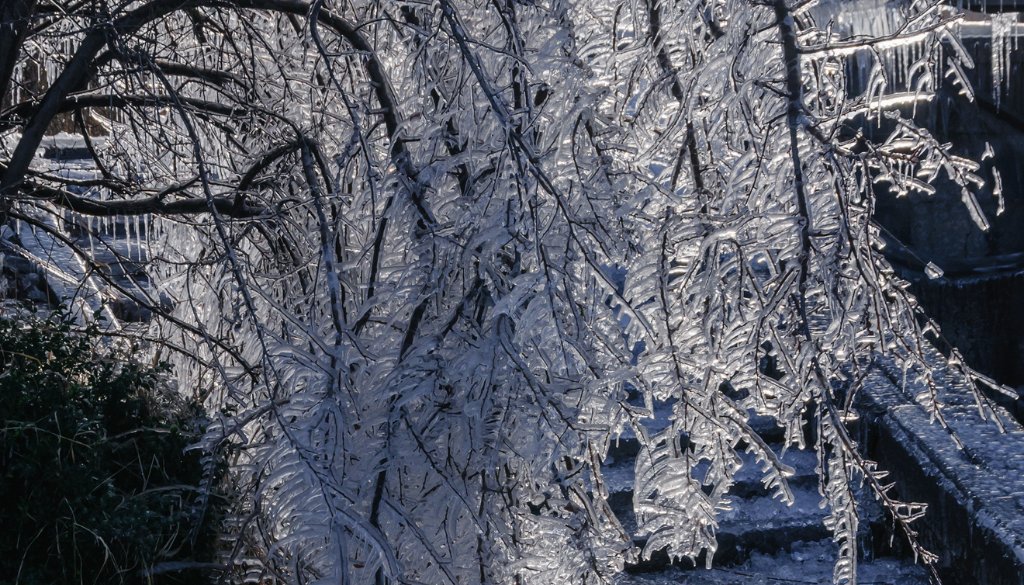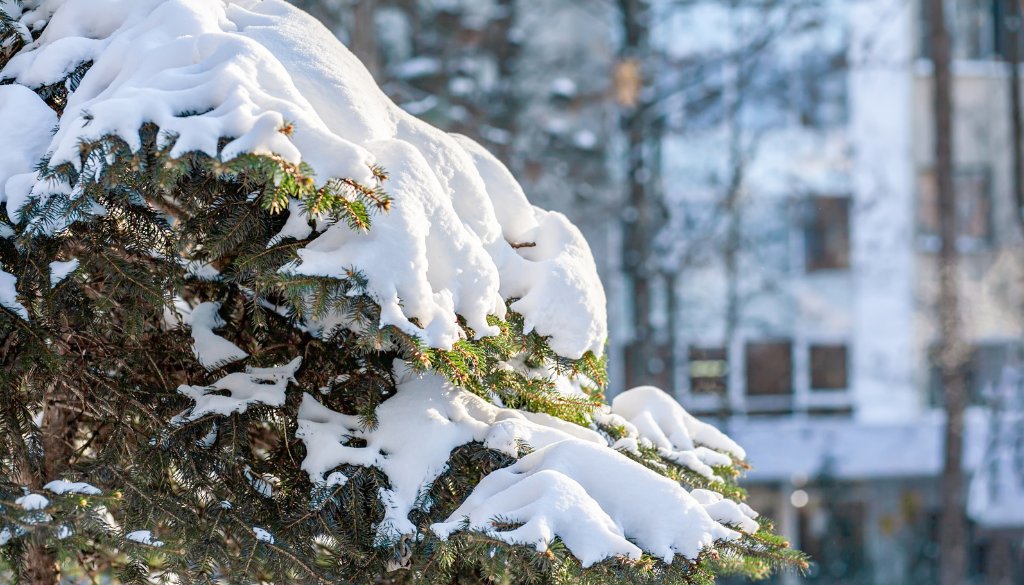Ice damaged trees fail for reasons that are physical, biological, and environmental. When freezing rain coats branches in a thick layer of ice, the added weight can exceed the structural limits of the wood. In New York City, soil is compacted, space is limited, and many trees are already stressed by salt, drought, or construction. That means the risk is higher than in these rural areas. A tree may survive the storm but carry hidden damage that shows up months later. This guide explains how ice causes injury, how to assess what’s recoverable, and what your options are.
Signs Your Tree Is Damaged After an Ice Storm
Damage from ice is not always obvious. Some broken limbs hang loosely, held by the tree bark. Others fall immediately. Look for signs like fractured or partially detached branches, ice-covered limbs that remain bent after thawing, vertical cracks in the trunk near major limbs, or missing twigs stripped clean by the weight of ice.
Soil and Bark
Bark may be torn or peeling where limbs broke off, and one side of the canopy might appear significantly thinner than the other. If the soil around the base is lifted or cracked on one side, or multiple limbs snapped by ice, especially from the same direction, the tree has likely suffered structural compromise. These are not cosmetic issues. They indicate instability that could lead to further failure in future storms.
Why Trees Get Damaged Under Snow and Ice
Ice does not break healthy wood without cause. The failure begins with weakness, which comes from poor structure, disease, or environmental stress. When the combined forces exceed the tree’s capacity, the failure occurs.
The physics are straightforward. Ice weighs about 57 pounds per cubic foot. A quarter-inch coating on a mature maple limb can add hundreds of pounds of pressure. Wood becomes brittle in cold temperatures, and frozen sap reduces flexibility. If the limb is already weakened by decay, insect infestation, or improper pruning, it cannot withstand the strain.
Tree Types
Some species are more vulnerable to ice and snow. Silver maples have shallow roots and weak branch unions. Bradford pears grow fast but develop narrow crotches that split easily. White pines have long, flexible limbs that catch snow and ice. Oaks and sycamores are stronger but not immune, especially if roots are confined by pavement or foundation walls. In urban settings, conditions worsen because salt from roadways damages the buds and roots. Unfortunately for us, trees grow where they can, not where they should.

Can Frozen Tree Branches Recover?
The recovery of an ice damaged tree depends on the extent of the damage. If a branch is bent but not broken and the bark stays intact, it can straighten as temperatures rise and the ice melts. Evergreens tend to recover better than hardwoods because their wood is naturally more flexible. A cracked or split limb has little chance of recovery since the vascular system inside the tree is severed, cutting off the flow of nutrients and water.
Even if the branch stays green for several weeks, it will eventually die. Once that happens, the dead wood becomes an entry point for all sorts of pests and decay. Damage to the main leader affects the tree’s overall structure and future growth pattern, leaving it weaker and more vulnerable.
What to Do When Tree Branches Are Covered in Ice
Do nothing and wait. Ice must melt naturally. Attempting to remove it by tapping, shaking, or hitting the limbs can cause fractures that aren’t visible until spring. The wood is brittle in cold and ice, and added force can break it. Keep people and pets away from the area. Falling ice is dangerous. Large chunks can weigh several pounds and fall from height. Clear walkways if possible, but do not go under the canopy. Once the ice melts, inspect the tree. Look for broken limbs, cracks, and bark damage. Take photos for insurance if needed and keep weather reports as documentation.

Should You Shake Snow Off Your Trees?
In a simple answer, no. Shaking snow off tree branches can break limbs, especially on evergreens and multi-stemmed trees. Snow bends the branches down, but most of them rebound when the load is lifted. Forcing the trees can cause permanent deformation or fracture.
If the snow is heavy and you can tell it poses a clear risk, use a soft broom to gently tap lower limbs from the ground. Never climb or use tools and avoid the upper tree canopy. For young or newly planted trees, supporting them may help. Use stakes or wires during winter storms, but remember to remove them in spring. Try to prune weak or crowded limbs in autumn. Avoid tree topping, and maintain proper mulch depth about three inches deep, six inches from the trunk, and pulled back to prevent rot and pests.
How to Fix Ice Damage on Trees
Most ice damage cannot be fixed, only managed. When limbs break, prune them back to the branch collar using sharp, sterilized tools. Leaving the stubs can slow the healing process and even create entry points for decay. Avoid painting the wounds. Clean cuts seal naturally and more effectively.
A split trunk usually means the tree is beyond saving. While cabling can offer temporary support, it doesn’t restore structural integrity. A cracked trunk traps moisture, promotes rot, and weakens the tree’s ability to withstand wind or snow. If more than half the canopy is gone, professionally removing your tree is often the safest choice.
The tree won’t regain its shape or strength and becomes a hazard over time. Wait until spring to assess and remove damaged wood. Note: Pruning too soon may take out live tissue that could help the tree recover.

Does Insurance Cover Ice-Damaged Trees?
Homeowners’ insurance often covers damage caused by a fallen tree, but not the cost of removing a standing, damaged tree. If the tree fell and hit your house, the cleanup might be covered. If it’s leaning but still upright, removal is usually your cost to cover. To file a claim, document the storm and the damage. Take photos, keep weather reports, and have an arborist report if possible. If the tree falls on a neighbor’s property, liability depends on the condition. If it is visibly unhealthy, you could be held responsible.
How to Prevent Ice Damage to Trees and Shrubs
Start with species selection. Plant strong-wooded trees like oaks, hornbeams, or serviceberry in exposed areas. Avoid silver maples, willows, and Bradford pears near structures. Prune regularly to remove weak, crossing, or narrow-angled branches. Structural pruning in youth prevents failure in maturity. Avoid topping, as it creates weak regrowth that breaks easily. Applying mulch correctly helps insulate roots and retain moisture during the winter months. A three-inch layer spread evenly around the base, while keeping it pulled back at least six inches from the trunk, prevents rot and discourages pests. Avoid piling it high into mounds, commonly called “mulch volcanoes,” which do more harm than good. Trees that enter winter in a drought-stressed state are more vulnerable to cold injury. Try watering your trees heavily in the fall before the ground freezes.
Can Tree Roots Freeze in Winter?
Rarely. Most roots are below the frost line. In New York, soil rarely freezes deeper than two feet and tree roots extend way beyond that. But in shallow soils, container-grown trees, or exposed sites, root damage can occur. Symptoms appear in spring: delayed leafing, stunted growth, dieback. Mulching can really help to insulate them.
When Damage Becomes a Warning
A bent limb or broken branch isn’t just damage, but information. It tells you the tree has reached its physical limit, that something in its structure, environment, or history couldn’t withstand the weight of ice, the force of wind, or just time. Or, it might point to weak branch unions, prior decay, or poor pruning years ago. It could mean the root system is already compromised or that the tree species was never suited for an exposed urban site. Paying attention now helps you understand what kind of risk the tree poses and whether it can recover, or if it’s time to act.

